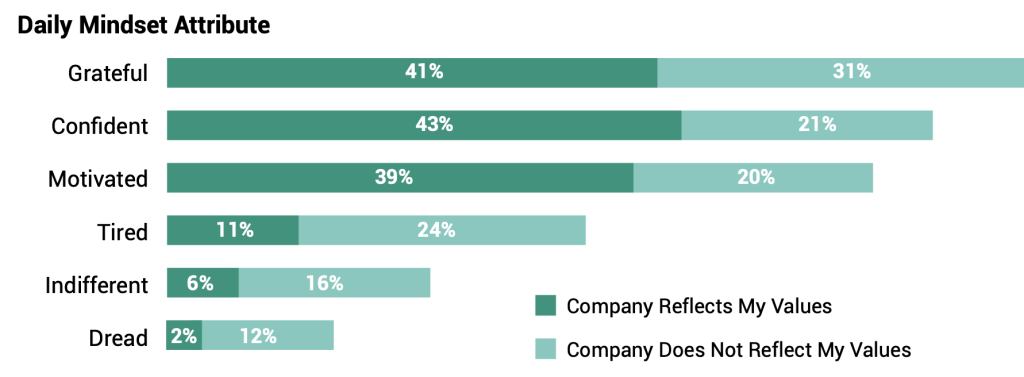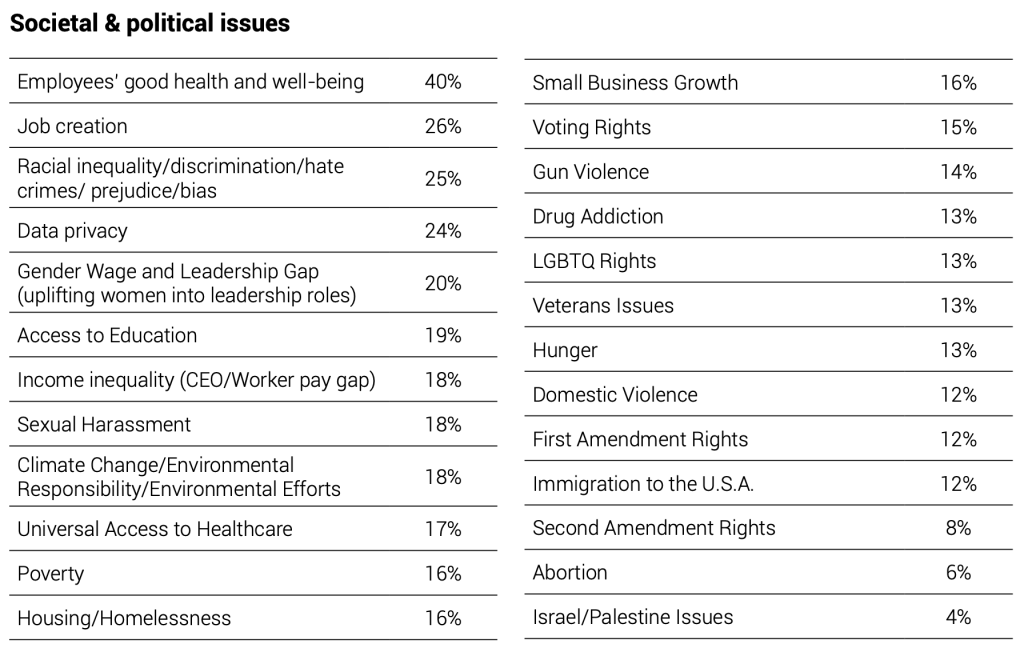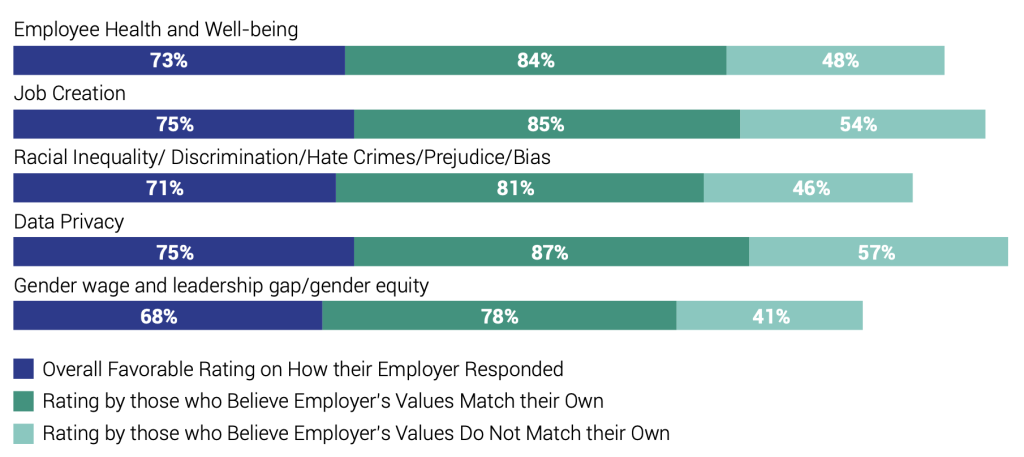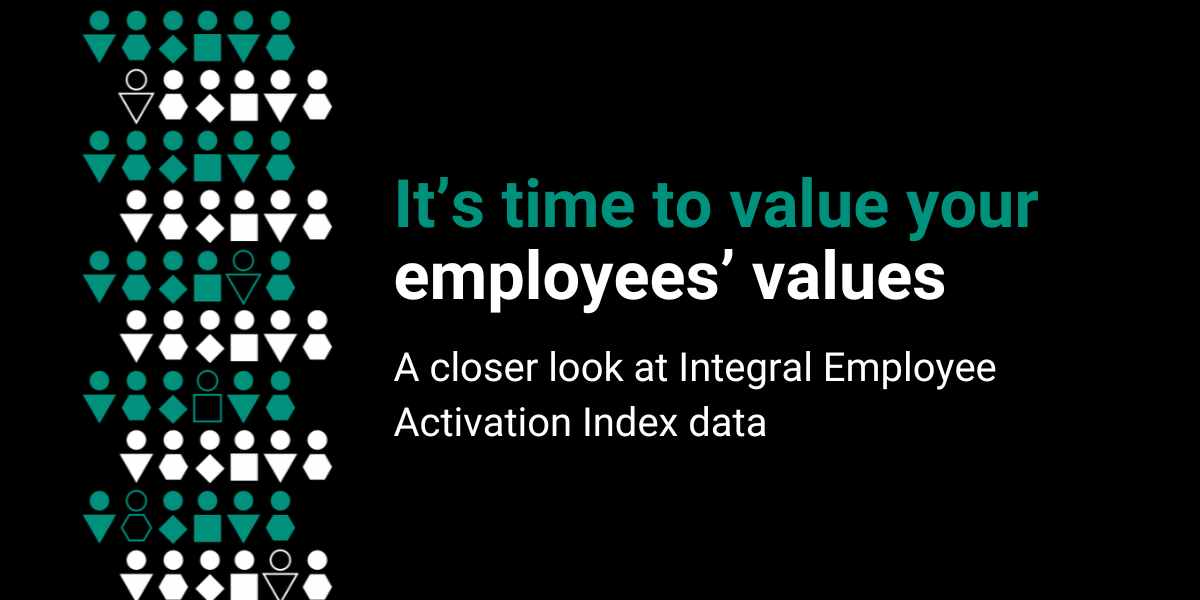A closer look at Integral Employee Activation Index data
Do company values need to match employees’ values? Not necessarily.
Yet, according to our inaugural Integral Employee Activation Index, more than 75% of those surveyed know and believe in their company’s values. So, it may be too soon to celebrate those high scores. As it turns out, there’s a significant gap showing 39% of respondents say their company’s values don’t reflect their values.
The values gap is costly
However, during a time of the Great Resignation, employers need to look at every lever to keep their talent from leaving. According to SHRM’s Human Capital Benchmarking Report, the average cost-per-hire was $4,129 in 2016, ($4,706 in 2021 when adjusted for inflation). The average time it takes to fill a position is 42 days. Our research indicates that the more a company’s values reflect its employees’ values, the less likely people are to change jobs.
Who’s likely to walk out the door—and why?

Values alignment is good for business
Since Jim Collins’ watershed book Built to Last: Successful Habits of Visionary Companies was published 25 years ago, companies have worked hard to create values. This means that if values are empty words, companies open themselves up to talent departures. If companies want to be seen as having a “values-led” culture, leaders need to demonstrate making decisions based on company values and show an understanding of what is on the mind of employees.
Create listening loops
Have senior leaders meet with a cross-section of employees to understand where personal values and organizational values align (or don’t). Creating a continuous listening landscape will help organizations learn and act to ensure the success of your organization. As Integral CEO & Founder, Ethan McCarty, noted, listening is the key to activate employee engagement. And, as Taylor Shawver, Integral’s Vice President, Strategy & Culture adds, listening helps create psychological safety, which is key to building trust. And trust is foundational to good working environments.
Measure what you value
Create programs to address significant gaps, and measure their impact. Repeat on a regular cadence and commit to reporting out impact whether results are in your favor or not. As Dan Ariely notes, “Human beings adjust behavior based on the metrics they’re held against. Anything you measure will impel a person to optimize his score on that metric.” So, ensure you measure what you value using SMART goals, adjusting your work using the data your goals get you.
The values gap impacts employees’ daily mindset
Organizations that don’t take their employees’ personal values and experience into account risk a workforce struggling to bring their best selves. The impact of employer values not reflecting employees’ values has a 2x negative factor, in many cases, on daily mindset. That is to say, it impacts the employee experience on a daily basis.

Empathy is the new superpower for managers
Certainly, the time for managers to show empathy and caring is now. In January 2021, there were nearly 64 million managers in the U.S, roughly 43% of all employees are managers. That puts managers in a key role to influence an organization, but they need the right tools. For example, according to a Harvard Business Review article, only 20% of managers have received any formal empathy training. Additionally, according to Forbes, 98% of managers believe managers at their company need more training to deal effectively with important issues such as professional development, conflict resolution, employee turnover, time management and project management. Essentially, managers are unprepared for the role they have.
Develop manager empathy skills
Companies have offered employees support in areas like mental health and childcare. This means that many employees now expect their managers to be part of their support system to help them improve their life experience as it affects their employee experience. Companies can reinforce meeting the needs of their most important public by making empathy part of the management performance model. When organizations invest in professional development, resources, and support, more managers will be better equipped to meet the needs of their direct reports.
Prioritize feedback mechanisms
As organizations look to increase empathy within their workforce, they’ll need to build new systems to motivate and reward adoption. Some may favor genuine, open conversations to develop empathetic relationships. This isn’t in everyone’s comfort zone; some will seek to avoid it. Leaders and managers will need to create a variety of pathways that meet people’s needs. HR departments will also need to put training and feedback loops in place that motivate adoption of empathy best practices across the workforce.
A wake-up call
Participants reflect United States demographics pertaining to genders, generations, racial backgrounds, and geographic area. Overall, across all participant responses, the top issues were employee health and well-being; job creation; racial inequality/discrimination/hate crimes/ prejudice/bias; data privacy; and the gender wage and leadership gap.
Issues that participants ranked low were hunger, domestic violence, and First/Second Amendment Rights.

Additionally, the Index found some notable generational and gender differences. These can serve as important guidelines for organizations as they develop employee programs. Gen Z ranked LGBTQ rights as the most important issue (32%); while men ranked job creation more important than women, who ranked gender wage and leadership gap/gender equality as more important than men did.
Employees who believe their organization reflects their values rate their organizations’ performance on the top issues as much as 25 to 30 points more positively than their peers whose values do not align.

Promote your ESG efforts
It takes courage and commitment for a company to publicly take a stance for or against issues. As always, companies continue competing for the best talent. For that reason, it is essential to design an employee journey built around employee values to help keep and attract talent.
As more employees stand up for what they believe in, employers can make an effort to direct this potential energy productively. Making a strategic commitment to the Environmental, Social, and Governance issues that matter to employees will help organizations become an “employer of choice.”
Shine a light on it
Don’t wait for the annual report. Incorporate ESG as a news feature in your regular employee communications: stories on the intranet, agenda topics in manager meetings, and during your all-hands meetings with transparency and accountability.
Measure what you care about
HR leaders should evaluate the effectiveness and use of your health and well-being support programs (the top-ranked employee issue). Build advocacy to promote such programs and measure engagement with them.
As you evaluate and reevaluate your values statements, remember to find ways to tie these to issues and concerns employees already have expressed.
About Integral
Integral is an award-winning Internal Communications and Employee Activation agency. Integral is more than a name—it’s our mindset. We know how to align what’s important to your employees with your values, using innovative approaches and channels to reinforce that alignment. Our specialty is helping global and national brands drive employee behavior change to achieve business goals and outcomes. Let’s talk.
About the Integral Employee Activation Index
Integral released our inaugural Employee Activation Index in September 2021, conducted in collaboration with The Harris Poll. Over 2,000 employees across four generations provided input about employee readiness to support organizational goals.
